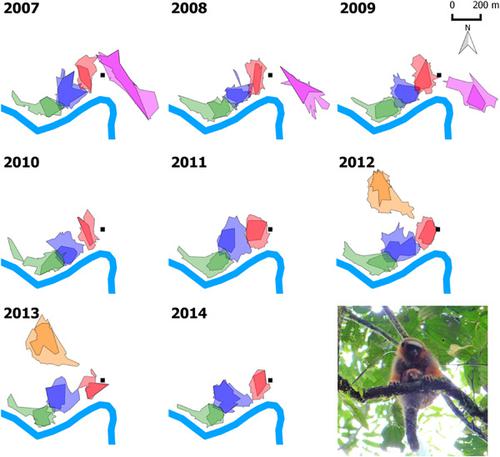当前位置:
X-MOL 学术
›
Am. J. Primatol.
›
论文详情
Our official English website, www.x-mol.net, welcomes your
feedback! (Note: you will need to create a separate account there.)
Ranging behavior and the potential for territoriality in pair‐living titi monkeys (Plecturocebus discolor)
American Journal of Primatology ( IF 2.0 ) Pub Date : 2020-12-28 , DOI: 10.1002/ajp.23225 Sarie Van Belle 1 , Amy M Porter 2 , Eduardo Fernandez-Duque 3, 4, 5 , Anthony Di Fiore 1, 5
American Journal of Primatology ( IF 2.0 ) Pub Date : 2020-12-28 , DOI: 10.1002/ajp.23225 Sarie Van Belle 1 , Amy M Porter 2 , Eduardo Fernandez-Duque 3, 4, 5 , Anthony Di Fiore 1, 5
Affiliation

|
Patterns of ranging behavior and space use are key for evaluating current ideas about the evolution and maintenance of pair‐living and sexual monogamy as they provide insights into the dispersion of females, the potential for territoriality, and whether males are limited to defending an area that can support only one female and her offspring. We examined ranging behavior and space use to evaluate the potential for territoriality in five groups of red titi monkeys (Plecturocebus discolor) during a 10‐year study in Ecuadorian Amazonia. Mean home range size, calculated using a time‐sensitive local convex hull estimation procedure, was 4.0 ± 1.4 ha. Annual home ranges of neighboring groups overlapped, on average, 0%–7%. Mean daily path length was 670 ± 194 m, resulting in defendability indices of 2.2–3.6 across groups. Groups visited, on average, 4 of 12 sections of their home range border area per day, but that was not more often than would be expected by chance, and intergroup encounters were infrequent. We did not find evidence of active monitoring for intruders in border areas, in that groups did not travel either faster or slower when at the border than when in central areas of their range. The absence of overt monitoring might be compensated for by engaging in loud calls, which the study groups did throughout their home ranges; these calls may serve as an advertisement of occupancy and a deterrent to intruding conspecifics. Our finding that red titis have a high potential for territoriality is consistent with several of the main hypotheses proposed to explain pair‐living in mammals.
中文翻译:

成对生活的山雀(Plecturocebus discolor)的测距行为和领地潜力
测距行为和空间使用模式是评估当前关于成对生活和性一夫一妻制的演变和维持的想法的关键,因为它们提供了对雌性的分散、领土的潜力以及雄性是否仅限于保卫一个区域的见解只能供养一只雌性和她的后代。我们检查了测距行为和空间使用,以评估五组红山雀(Plecturocebus discolor) 在厄瓜多尔亚马逊河流域进行了 10 年的研究。使用时间敏感的局部凸包估计程序计算的平均家庭范围大小为 4.0 ± 1.4 公顷。邻近群体的年度家庭范围重叠,平均为 0%–7%。平均每日路径长度为 670 ± 194 m,导致各组的防御指数为 2.2-3.6。团体平均每天访问其家乡边境地区 12 个部分中的 4 个,但这并不比偶然预期的要频繁,而且团体间的相遇很少见。我们没有发现在边境地区对入侵者进行主动监控的证据,因为这些团体在边境时的旅行速度并不比在其活动范围的中心地区时快或慢。可以通过大声呼叫来弥补公开监控的缺失,研究小组在整个家庭范围内都这样做;这些电话可以作为入住的广告和对入侵的同种的威慑。我们发现红耳炎具有很高的领地潜力,这与提出的用于解释哺乳动物中成对生活的几个主要假设是一致的。
更新日期:2020-12-28
中文翻译:

成对生活的山雀(Plecturocebus discolor)的测距行为和领地潜力
测距行为和空间使用模式是评估当前关于成对生活和性一夫一妻制的演变和维持的想法的关键,因为它们提供了对雌性的分散、领土的潜力以及雄性是否仅限于保卫一个区域的见解只能供养一只雌性和她的后代。我们检查了测距行为和空间使用,以评估五组红山雀(Plecturocebus discolor) 在厄瓜多尔亚马逊河流域进行了 10 年的研究。使用时间敏感的局部凸包估计程序计算的平均家庭范围大小为 4.0 ± 1.4 公顷。邻近群体的年度家庭范围重叠,平均为 0%–7%。平均每日路径长度为 670 ± 194 m,导致各组的防御指数为 2.2-3.6。团体平均每天访问其家乡边境地区 12 个部分中的 4 个,但这并不比偶然预期的要频繁,而且团体间的相遇很少见。我们没有发现在边境地区对入侵者进行主动监控的证据,因为这些团体在边境时的旅行速度并不比在其活动范围的中心地区时快或慢。可以通过大声呼叫来弥补公开监控的缺失,研究小组在整个家庭范围内都这样做;这些电话可以作为入住的广告和对入侵的同种的威慑。我们发现红耳炎具有很高的领地潜力,这与提出的用于解释哺乳动物中成对生活的几个主要假设是一致的。











































 京公网安备 11010802027423号
京公网安备 11010802027423号